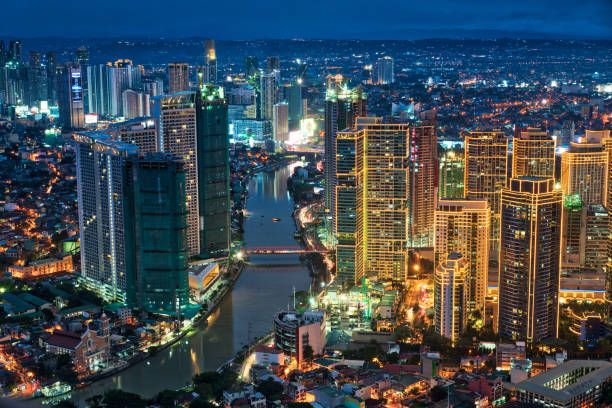The warm and humid weather in the Philippines is a common occurrence during this time of year. The easterlies, also known as trade winds, play a significant role in shaping the country’s climate. These winds originate from the Pacific Ocean and carry with them moisture and warmth, creating a tropical and humid environment.
As the easterlies sweep across the archipelago, they bring with them not only warm temperatures but also high levels of humidity. This combination can make the weather feel even hotter than it actually is, as the humidity prevents sweat from evaporating efficiently from the skin. This can lead to discomfort and a sense of stickiness, particularly in urban areas where the heat is exacerbated by the concrete jungle effect.
While the warm and humid weather is a characteristic of the Philippines, it can vary in intensity and duration depending on several factors. One such factor is the presence of weather systems such as tropical depressions or typhoons. These systems can enhance the easterlies, leading to even higher temperatures and more intense humidity. Conversely, the absence of such systems can result in milder and more pleasant weather conditions.
Despite the challenges that come with warm and humid weather, the Philippines has learned to adapt and thrive in these conditions. From traditional architecture that maximizes airflow to the widespread use of electric fans and air conditioning, Filipinos have found ways to stay cool and comfortable. Additionally, the country’s abundant natural resources, such as beautiful beaches and lush mountains, provide opportunities for outdoor activities that allow people to enjoy the warm weather while staying refreshed.
It is important, however, to take necessary precautions when dealing with extreme heat and humidity. Staying hydrated, wearing light and breathable clothing, and seeking shade during the hottest parts of the day are essential to staying safe and healthy. The government and various organizations also provide public advisories and reminders to ensure that everyone is well-informed and prepared.
As the warm and humid weather continues to envelop the Philippines, it is a reminder of the country’s unique tropical climate. It is a testament to the resilience and adaptability of its people, who have learned to embrace and make the most of the weather conditions that shape their lives.
Impact on Specific Regions
The easterlies, a dominant weather system in the Philippines, are particularly affecting several regions in the country. One of the regions experiencing the impact of the easterlies is the Bicol Region, located in the southeastern part of Luzon. This region, known for its beautiful landscapes and active volcanoes, is now facing the effects of the easterlies in the form of scattered rain showers and thunderstorms. The combination of the warm and moist air brought by the easterlies with the region’s geographical features creates an ideal condition for the development of convective clouds, leading to the occurrence of rain showers and thunderstorms.
Another region affected by the easterlies is the Eastern Visayas region, specifically Northern Samar, Samar, and Eastern Samar. These provinces, located in the central part of the Philippines, are also experiencing scattered rain showers and thunderstorms, particularly in the afternoon or at night. The easterlies, blowing from the east, bring moisture from the Pacific Ocean, which interacts with the local topography and atmospheric conditions, resulting in the formation of rain clouds and thunderstorms.
Furthermore, the province of Quezon, situated in the southern part of Luzon, is also experiencing the impact of the easterlies. This province, known for its agricultural activities and natural attractions, is now facing scattered rain showers and thunderstorms as a result of the easterly winds. The easterlies bring moisture from the Pacific Ocean, which collides with the warm air over the land, leading to the formation of rain clouds and thunderstorms in the region.
It is important for residents and visitors in these affected regions to stay updated with the latest weather advisories and take necessary precautions. The scattered rain showers and thunderstorms can bring heavy rainfall, strong winds, and lightning, which may pose risks to people’s safety and property. It is advisable to avoid outdoor activities during severe weather conditions and to secure loose objects that may be blown away by strong winds.
In conclusion, the easterlies are currently impacting various regions in the Philippines, including the Bicol Region, Northern Samar, Samar, Eastern Samar, and Quezon. These regions can expect to experience scattered rain showers and thunderstorms, especially in the afternoon or at night. Understanding the effects of the easterlies and being prepared for severe weather conditions are crucial in ensuring the safety and well-being of the communities in these areas.
Weather Outlook for the Country
Despite the presence of the easterlies, most parts of the country will still have generally fair weather. However, there may be isolated instances of rain showers and thunderstorms in some areas. PAGASA advises that temperatures will continue to soar until Easter Sunday due to the easterlies.
PAGASA’s 5 a.m. advisory states that the easterlies, combined with localized thunderstorms, will result in partly cloudy to overcast skies with isolated downpours or thunderstorms in Metro Manila and the rest of the country.
As we head into the summer season, it is important to stay updated with the latest weather forecasts and advisories from reliable sources like PAGASA. The easterlies, which are prevailing winds coming from the east, can bring warm and humid air to the country. This can lead to the formation of cumulus clouds and potential thunderstorms, especially in the afternoon or evening.
While most areas will experience fair weather, it is crucial to note that localized thunderstorms can still occur, bringing heavy rain and lightning. These thunderstorms can be unpredictable and may develop rapidly, so it is important to be prepared and take necessary precautions.
It is also worth mentioning that weather conditions can vary significantly across different regions of the country. The Philippines is an archipelago composed of numerous islands, each with its own unique climate and topography. Factors such as elevation, proximity to bodies of water, and geographical features can influence local weather patterns.
For example, coastal areas may experience cooler temperatures and higher chances of rain due to the influence of sea breezes. Inland areas, on the other hand, may have higher temperatures and less rainfall. Mountainous regions can also create their own microclimates, with cooler temperatures and higher chances of fog or mist.
Understanding these regional variations is important for planning outdoor activities, agriculture, and disaster preparedness. Local laws and customs may also be influenced by these weather patterns, such as fishing practices, farming techniques, and traditional festivals.
Therefore, when considering the weather outlook for the country, it is essential to take into account the diverse and dynamic nature of the Philippines’ climate. By staying informed and adapting to local weather conditions, we can make the most of our experiences and ensure our safety and well-being.







